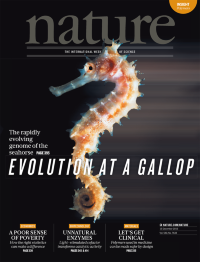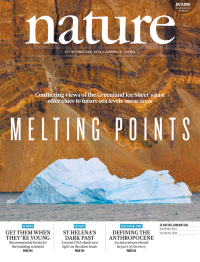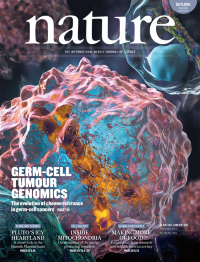Volume 540
-
No. 7634 22 December 2016
Once again, we end the year by selecting Natures Ten, ten scientists whose work this year has had an important impact in their respective fields. They are Gabriela Gonzalez, Demis Hassabis, Terry Hughes, Guus Velders, Celina Turchi, Alexandra Elbakyan, John Zhang, Kevin Esvelt, Guillem Anglada-Escud and Elena Long. Cover: Gravity waves JVG/Folio art
-
No. 7633 15 December 2016
A seahorse at the Lembeh Strait, Sulawesi, Indonesia. Seahorses are prime examples of the exuberance of evolution and are unique amongst bony fish on several counts, including their equine body shape and male brood pouch. An international collaboration reporting in this issue of Nature has determined the genome sequence of a seahorse (Hippocampus comes, the tiger tail seahorse). They find it to be the most rapidly evolving fish genome studied so far. H. comes is among the most commonly traded seahorse species � dried for traditional medicines and live for the aquarium trade � and is on the IUCN Red List as a vulnerable� species. Analysis of the genomic sequence provides insights into the evolution of its unique morphology. Of note is the absence of a master control gene, tbx4, which functions in the development of hindlimbs and pelvic fins. Pelvic fins are missing in seahorses, and tbx4-knockout mutant zebrafish also lack pelvic fins. Cover: Jeff Rotman/Getty Images
-
No. 7632 8 December 2016
Iceberg and fjord walls, Scoresby Sund , East Greenland. If the Greenland Ice Sheet were to melt completely, global sea levels would rise dramatically, perhaps by several metres. Two studies published in this issue of Nature, by Joerg Schaefer and colleagues and by Paul Bierman and colleagues, examine the past behaviour of the ice sheet to help evaluate its vulnerability in a warming world. Although analysing the same cosmogenic isotopes, the two groups arrive at seemingly conflicting conclusions. In a News & Views Forum, two geochemists and a glaciologist discuss the issues arising from these papers. Cover: Frans Lanting/National Graphic Creative
-
No. 7631 1 December 2016
Malignant germ cells with loss of heterozygosity undergoing apoptosis. Tumours formed from germ cells those cells that develop in the embryo to become the cells of the reproductive system tend to be more sensitive to chemotherapy than are many other adult cancers. To establish the basis for this chemosensitivity and the drivers of clinical resistance, Eliezer Van Allen, Christopher Sweeney and colleagues performed clinical whole-exome and transcriptome sequencing of germ-cell tumours from patients with various clinical outcomes, including the very rare case of death from germ-cell tumours. They find that primary germ-cell tumours are highly enriched for chromosomal reciprocal loss of heterozygosity, and for mutations in KRAS, and have high mitochondrial priming. This work provides insights into chemosensitivity and the evolution of chemoresistance in germ-cell tumours. Cover: Ella Marushchenko & Elina Korobenko (Ella Maru Studio, Inc.)




